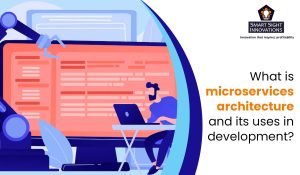 Synopsis: Microservices is a modern organizational practice with its roots in innovative software engineering. If you are considering implementing microservices, then your goal is to build applications by splitting each business component into a standalone service.
Synopsis: Microservices is a modern organizational practice with its roots in innovative software engineering. If you are considering implementing microservices, then your goal is to build applications by splitting each business component into a standalone service.
In doing so, you may develop an app and some services that can be used on their own and integrated into future applications. Getting a cutting-edge perspective on microservices strategy can help you know when, where, why and how you should be using microservices.
Microservices architecture is an architectural style for developing applications. It allows a large application to be broken down into smaller independent parts, each with its role and responsibility. To satisfy a single user request, a microservices-based application can invoke multiple internal microservices to generate its response.
Understanding how to build microservices, their uses and going through some of the programming languages will help you in getting your job done.
How to build a microservices architecture
Are you considering building a successful microservices architecture? If yes, then you should follow these three essential steps:
-
Build a monolith architecture first
You should begin with a monolith architecture. Do this before an application can become part of a microservices environment. This is an important step because every idea starts on a simple note but becomes more complex as the reaction cycle approaches. You begin to identify the more important functions that are worth adding to your app.
For example, if you are building an e-commerce mobile application, the main idea is to create an interface where the user can browse the catalog, add items to their cart and make payments. And, you’ll decide if creating an account for users is worth it.
When you start collecting feedback, you may also find that it is important for users to integrate a customer review system.
Therefore, you can identify other useful capabilities, such as an integrated order tracking system, an automated returns portal and more. You may find these things count for your customers and give you an edge over your competitors.
The research phase is where you can begin to identify whether an application is worth breaking down into microservices. But you can only do this by starting with a monolith and then working out.
-
Re-organize your internal teams
You might assume that microservices architecture is highly technical. But the success of your microservices enterprise depends largely on your internal teams and their ability to support this environment. Your organization will produce a design that speaks well of internal communication.
When adopting microservices, your team will be an asset. Let’s say you have a back-end team, front-end team and operations team. Your front-end and back-end teams will independently build monoliths that go to your operations team for production. But it is not effective for a successful microservices architecture.
For efficient internal restructuring, treat each service as a standalone product. This means creating small teams, each with the skill needed to develop and maintain the service from start to finish. Without restructuring, microservices would not be sustainable in the future.
-
Take a calculated approach to execution
Ensure the success of your microservices architecture by following the best practices.
Simple communication between services matters. A reliable service provider can help by making API management hassle-free. Break down your database to isolate your services, improving uptime and security. Similarly, build your architecture for failure.
Invest in advanced monitoring and testing to make and manage microservices more efficient and faster. Adopt a continuous delivery model to avoid friction during the development and testing phases and improve delivery times.
How to choose architecture language
Microservices allow you to build a reliable platform for extending the business while also benefiting from multiple programming languages and technologies. And, it would be best to standardize the tech stack by choosing a programming architecture language based on your business needs, and the following criteria:
-
Allows full automation support
Today, automation is the key to any product development. And the best microservices development tools or microservices programming languages should support automation to streamline and expedite the entire deployment process. It also ensures fewer errors or imperfections during deployment and in the final product.
-
Should be easy to monitor
As you know by now, the microservices architecture allows the development of many smaller components rather than the entire product. While this increases the efficiency and reliability of the product, it also makes the monitoring process a bit daunting as developers can deploy multiple components at a time.
To make this task easier, always opt for programming languages for microservices that are easy to monitor.
-
Has a consumer-centric approach
For app development, consumers should be your priority. So you must take into account several factors, such as how useful the app will be to the end-users, how efficiently it can provide the required solution and more. Therefore, this approach is a mandatory criterion when choosing microservices development tools and architecture languages.
-
Provides decentralized components
In decentralization, different teams, processes, and processes fragment to promote accelerated, agile development. Companies and developers are moving away from building monolithic software projects and using microservices agility to separate services and deliver solutions faster.
Decentralization optimizes all the benefits offered by microservices architecture. It helps to maximize production efficiency and significantly reduce product development time. So your chosen programming language for microservices should be compatible with this approach.
-
Support for independent development
In a microservices architecture, large software projects break down into smaller, more independent modules. For high definition and discrete tasks, these individual modules communicate with each other through simple, universally accessible APIs.
So, independent development is one of the factors that makes microservices architecture stand out from the other traditional architectures. But the chosen programming language must suit this kind of development. If it does, then you have followed an important criteria in choosing the best language for microservices.
Use of microservices
Microservices architecture is very important for any app development, especially for large-size app development. This design helps to break down the entire large application into smaller independent parts. Each part is in charge of operation separately, to increase the application efficiency and reliability, as in:
Data processing
A microservices platform can extend cloud support to existing modular data processing services.
Website migration
A complex website hosted on a monolithic platform can be migrated to cloud-based and container-based microservices platforms.
Media content
Using microservices architecture, images and video assets can be stored in a scalable object storage system and served directly on the web or mobile device.
Invoicing part
Payment processing and order can be separated as independent units of services. So, payments will continue to be accepted even if invoicing is not working.
For e-commerce
Retailers can use different services for billing, accounts, merchandising, marketing and campaign management. This approach allows integration and fewer problems. If there is an issue with the retailer’s payment provider, developers can debug without affecting services such as marketing and merchandising.
Bottom line
Building microservices architecture is not only highly technical, but also requires changes in how you manage your projects internally. This can make it somewhat daunting, but with the right resources at your side, you’ll be able to reap the benefits of microservices development sooner.
Each technical decision depends on the tools you will use to develop other parts of your application. It also depends on the expertise and knowledge of your development team. Choose a service provider that helps you make the right decisions for long-term success.













